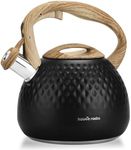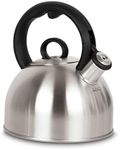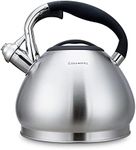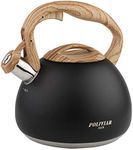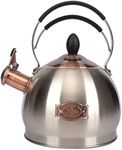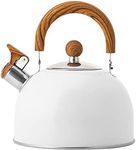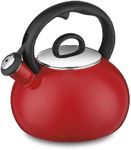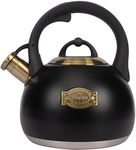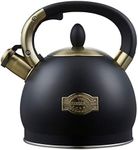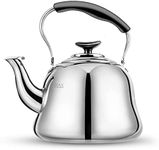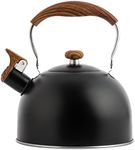Buying Guide for the Best Stovetop Tea Kettles
Choosing the right stovetop tea kettle can make your tea-making experience more enjoyable and efficient. The best kettle for you will depend on your daily habits, kitchen setup, and personal preferences. When shopping, it's important to consider how often you'll use the kettle, what kind of stove you have, and whether you value features like quick boiling, easy pouring, or stylish design. Understanding the key specifications will help you find a kettle that fits seamlessly into your routine and lasts for years.MaterialThe material of a stovetop tea kettle affects its durability, heat retention, and appearance. Common materials include stainless steel, glass, copper, and enamel-coated steel. Stainless steel is popular for its rust resistance and easy cleaning, while glass lets you see the water level and is non-reactive. Copper heats quickly but requires more maintenance, and enamel-coated kettles offer colorful designs but can chip if dropped. If you want a low-maintenance, long-lasting kettle, stainless steel is a safe bet. If you care about aesthetics or want to watch the water boil, glass or enamel might be more appealing. Think about how much effort you want to put into cleaning and maintaining your kettle when choosing the material.
CapacityCapacity refers to how much water the kettle can hold, usually measured in liters or quarts. Small kettles (under 1 liter) are great for individuals or couples who make just a cup or two at a time. Medium kettles (1–2 liters) suit small families or those who entertain occasionally. Large kettles (over 2 liters) are best for big families or frequent hosts. To pick the right size, consider how many people you usually serve and how often you make tea or other hot drinks. A larger kettle is convenient for groups, but a smaller one heats up faster and is easier to handle for solo use.
Compatibility with StovetopsNot all kettles work on every type of stove. Some are designed for gas or electric stoves, while others are compatible with induction cooktops. Induction-compatible kettles have a magnetic base, which is necessary for induction heating. If you have an induction stove, make sure the kettle is labeled as induction-ready. For gas and electric stoves, most kettles will work, but check the manufacturer's recommendations. Choosing the right compatibility ensures your kettle heats efficiently and safely on your stove.
Spout Design and PouringThe spout design affects how easily and accurately you can pour water. Some kettles have a gooseneck spout, which gives you precise control and is ideal for pour-over coffee or delicate tea brewing. Others have a wider spout for faster pouring. If you mostly make regular tea, a standard spout is fine. If you enjoy specialty brewing methods or want to avoid spills, look for a gooseneck or well-shaped spout. Consider your pouring needs and whether you value control or speed.
Whistle FeatureMany stovetop kettles have a whistle that sounds when the water reaches boiling. This feature helps prevent the kettle from boiling dry and alerts you when your water is ready, even if you're in another room. Some people find the whistle essential, while others prefer a quieter kitchen. If you tend to get distracted or multitask, a whistle can be very helpful. If you dislike loud noises, look for a kettle with a removable or adjustable whistle.
Handle Comfort and SafetyThe handle should be comfortable to grip and stay cool while the kettle is hot. Some handles are made of heat-resistant materials or have ergonomic shapes for easier pouring. If you have limited hand strength or want to avoid burns, look for a kettle with a well-insulated, sturdy handle. Test the handle's feel if possible, and consider how easy it will be to lift and pour when the kettle is full.
Ease of CleaningA kettle that's easy to clean will stay looking good and work well for longer. Wide openings make it easier to reach inside for scrubbing, while some materials (like stainless steel and glass) resist stains and odors. If you want minimal maintenance, choose a kettle with a large lid and smooth interior. If you use your kettle daily or live in an area with hard water, easy cleaning will save you time and effort.
